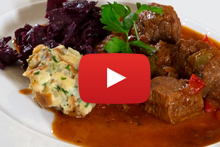
Chef Benoît Teisseire - GERMANY
Jürgen and Lisel are very busy today. They are going to have their kids and grandkids for the traditional Sunday lunch. Their residence is in the little town of Springe in Lower Saxony, Germany. Oma Lisel is preparing a nice "Wiesse Bohnensuppe" (White bean soup) and a delicious meatloaf baked in a Römertopf, a pot cookery made of clay that was given to her as a wedding gift and used for special occasions, to accompany it. The food cooked in this kind of bowl requires no liquid and no fat. The result incorporates all-natural juices, the full flavor and taste, and all the essential nutrients and vitamins are retained. It always feels ceremonious when using this pot. The meatloaf drips with rich, savory juices and a heavenly aroma fills the air from the healthy, life-giving ingredients of organic vegetables like green bell pepper and sweet vidalia chopped onions mixed with some fresh, fragrant herbs and savory spices. Opa and Jürge with their two grandchildren, Emma and Jacob, are proud to have made a flavorful contribution of some fresh mushrooms that they found in the woods; it doesn't get more wholesomely authentic than that! The dish will be served with "Kartoffelnödeln" (potato dumplings) and roasted rustic brussels sprouts. To complement this divine dish, a nice Trollinger red wine for the adults and apleshorle (apple juice mixed with sparkling water) for the kinders, this lunch will be scrumptious. But this meal wouldn't be complete without a luxurious confection, the parents, Elisa and Matthias, brought a "Schwarwälder Kirschtorte" (Black forest cake) for dessert. Getting together with the family for the usual Sunday feast is something to look forward to, especially with such a mouthwatering menu.
Rated restaurants by the Michelin guide, in 2017, awarded Germany to be the world's second-most decorated country, after France. Ten of them received three stars, thirty nine with two stars and two hundred fifty three received one star. Each region has a different variety of "cuisine." Germany is divided into 16 states; for instance, Baden-Württemberg is well known for a variety of smoked ham produced in the Black Forest region as well as plates prepared with some of the most superb, flavorsome white asparagus. Another example is the state of Brandenburg, it's called "Berlin's vegetable garden" due to a great variety of natural and organic products. One of the most famous vegetables prepared there is the "Spreewälder Gurke" (Spreewald cucumber). The little luscious cucurbits are placed in large barrels for the fermentation process; then basil, lemon balm, wine, cherry and/or nut leaves are added to give the Spreewald cucumber its unique, distinctive taste. Lower Saxony is also a part of Germany well known for its gourmet culinary diversity. There are two distinguishing dishes from this particular region, one is the Schlachteplatte, which consists of a variety of different meats such as smoked pork, different sorts of sausages, and bacon served with sauerkraut and potatoes. This plate is a little similar to the French choucroute. And the other specialty is the Calenberger Pfannenschlag (also known as Rinderwurst) composed of a fatty black pudding made from porridge and boiled pork and beef, served on bread. And, of course, the universally known state of Bavaria; this region is famously acclaimed for the world-renowned Oktoberfest. On October 12th, 1810, then King Ludwig married Princess Therese of Saxe-Hildurghausen. The citizens of Munich were invited to the festivities in front of the city gates, in a field that was renamed Theresa's Meadow in honor of the Princess. Six days subsequent to the wedding, the newlyweds continued to be celebrated with the spectacle of horse races; thereafter, this sport as well as other amusements were repeated and that was the beginning of the annual Oktoberfest tradition. In 1887, the parade and the participation of breweries took place for the first time. Every year attendance increased. For the 100th anniversary in 1910, approximately 12,000 guests showed up for the festivities and about 120,000 liters (31,700 gallons) of beer was consumed. Today, during the 17 day event, 7,200,000 visitors drink approximately 6,900,000 liters (1,822,787 gallons). Obviously, food can also be purchased, pork sausages, pork shanks, beef, calf meat, chicken and the famous pretzel. If you ever get a chance to visit Germany during this seasonal event, go hungry and thirsty!
As we all know, Germany has a lot of sausages. It is said that there are about 1500 kinds that vary between region and maker. The bratwurst and rostbratwurst are made of finely minced pork and beef; they are usually grilled and served with sweet mustard on a piece of bread. And one of the most popular ways to eat it -- is to slide and serve with a ketchup-curry sauce; this version is called the currywurst. The Nürnberger is smaller and flavored with marjoram. The blutwurst, or blood sausage, is made with congealed pig or cow blood, fat, bread or oatmeal. And, in Frankfurt, it's made with veal and some pork; this one is boiled and eaten with mustard and potato salad on the side. The complete list would be too exhaustive to mention, but we can say that you will always find the right one for you.
And, of course, there is the beer! By 500 A.D., they were brewing a thin beer made from oats. This was the work of the women. When Christianity got stronger in northern Europe, the monks started to brew for their own consumption and with the progression of time even sold it. They became really good at it and the final product was better than the homemade one. This may be because they had more time to refine the making process than the housewives did. In the 13th century, hundreds of monasteries were brewing. Anyone who chose to brew could use the income as payment for taxes to the nobility. The beer we consume today is made with hops. It took many centuries for this cereal to become part of the brewing process, just because the mixture has to be boiled for about ninety minutes. Then, beer was made of grains, hops and water. It was in 1860, with the discovery by Louis Pasteur, that the addition of yeast to the process of fermentation became part of the fabrication of this beverage. Today there are three different varieties: the wheat, pale and dark beer. Also many macro breweries make other types like IPA and Ale beer. So with about 5,000 brands produced in 1,300 industrial plants, you will have a wide range of choices…
Now, moving on to another German staple that has found its way universally into the every day menus of many. In the early 18th century, at the port of Hamburg, sailors and fishermen often ate minced and chopped meat called: the Hamburg Steak. It was prepared that way because the butchers were using the cheap part of cow meat. The ground beef was simply cooked with salt and pepper and served, at this time, without bread; it was just a beef patty. By migrating worldwide, the Germans introduced it and the hamburg steak became a mainstream dish in the 19th century in America. Many German immigrants to the United States opened restaurants in big cities, like New York and Chicago, selling this dish for about 10 cents. It was the most expensive dish on the menu. Then, throughout time, it became the popular hamburger, that we all know today and can be found in fast food as well as top-notch restaurants. The difference between the Hamburg Steak and the Hamburger is that it is served between two slices of bread roll or bun. Generally, it is suggested to eat with cheese, lettuce, tomato, bacon, onion and some mayonnaise or ketchup or other sauce. Today, there are a lot of variations of burgers; not only prepared with ground beef, but also with chicken, fish, pulled pork and bison meat. The oldest restaurant to serve this popular item – is Louis' Lunch in New Haven, Connecticut; it was establish in 1895. Legend has it that, in 1900, a client who was in a hurry requested his meal to go by putting the patty in a slide bread roll. Louis Lassen's restaurant is now recognized in the Library of Congress as the originator of the hamburger.
The German Residence in Washington, D.C. has the reputation of having one of the best "tables" in our nation's capital! Their secret is Chef Benoît Teisseire. Preparing breakfast, lunch and dinner for anywhere from 2 to 40 guests daily, he is always giving it his best to create the most delicious and authentic plates. When he was four years old, he always wanted to help his mother in the kitchen. At the age of fourteen, he visited a trade fair about employment and opportunities in the artisan profession in Paris, France and this was when he knew that he wanted to become a chef. His career is extremely impressive.
Thank you, Chef Benoît Teisseire!
Guten Appetit!
 Chestnut Soup with Porcini mushroom |
 Rindergulash (German Beef Goulash) |
 Rote grütze with vanilla sauce |
Download Recipes |
- Apartments, Housing, and Real Estate
- Automotive Sales & Leasing - Cars, SUVs & Trucks
- Clothing & Apparel
- Communications & Technology
- Concierge Services
- Contracting
- Dining & Entertainment
- Education
- Event Planning Services
- Financial Services
- Health & Beauty
- Home Furnishings
- Hotels & Accommodations
- Insurance
- Medical & Dental Services
- Office Services
- Property Management
- Security Services
- Shipping & Moving Services
- Specialty Services
- Travel & Transportation









